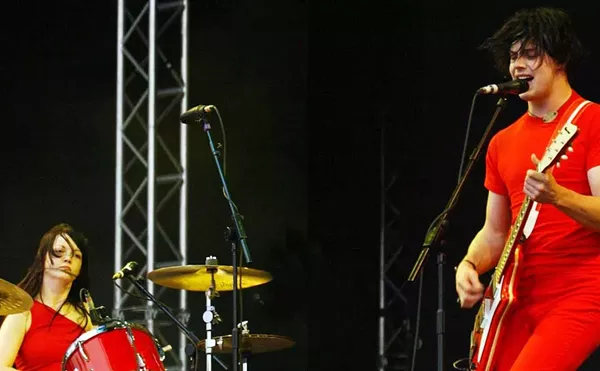
Audio By Carbonatix
[
{
"name": "GPT - Leaderboard - Inline - Content",
"component": "35519556",
"insertPoint": "5th",
"startingPoint": "3",
"requiredCountToDisplay": "3",
"maxInsertions": 100,
"adList": [
{
"adPreset": "LeaderboardInline"
}
]
}
]
Because music is a cauldron, because it’s that boundless arena where vibrations meet, clash, combine and form new sounds, we should be thankful. Music refuses to conform to society’s rules, and instead offers a voice to anyone willing to speak aloud.
Through music, conformists assimilate to whatever genre they choose. Rebels throw up middle fingers at whatever sanctity-invading creatures they deem deserving. Regardless, everyone shines. Everyone gets to create something. Some get rich. But to the true artist, what matters most is the legacy they leave.
So what can be said about the hybrid sound that has been popularized by such groups as Korn and Rage Against the Machine, and is now being spearheaded by Limp Bizkit, currently the nation’s top-selling group (to say nothing of Detroit’s own hip-rock fusionist Kid Rock – ed.)? Limp’s music, a "clash" between hip-hop bravado and metal fury, has gained a following of millions. And though it’s somewhat true that any loud and loose rhythm can find a market in today’s youth, how does Limp Bizkit’s class compare to core groups of its two musical parents, hip hop and metal?
Limp Bizkit co-founder Fred Durst credits the Korns, Rages and Deftones of the industry as the groups responsible for popularizing its punk-hop sound. But the seed of this "sound" may have been planted years ago. Groups such as Bizkit admit the influence of hip hop on their music. "I’ve been rhyming since ’82," says Durst.
"I’ve been breakdancing professionally. I’ve done DJing. I love breakdancing, man."
Durst’s path was paved, though, during the mid-’80s. It was then that Run DMC teamed with Aerosmith to record "Walk This Way." Even earlier, though, legendary rap group UTFO collaborated with legendary metal group Anthrax – both would record their own "rap" cut, "I’m the Man," and, later, hook up with Public Enemy – on the former’s Lethal album. The Anthrax-UTFO union was less than pleasing, but the interest in rock-rap fusion was nevertheless officially articulated. And what of the experimental soundtrack to the 1993 flick Judgment Night that paired rappers with alternative bands? Ultimately, might we also agree that the Beastie Boys began their careers doing exactly what Bizkit does now?
Korn’s appearance on the world stage was not only a testament that rap had influenced suburbia and white America, but it proved that music from the two different cultural spectra have a lot in common. Punk-metal is the music of an "X" generation written off as technology-driven, self-serving care-naughts. Hip hop is the war cry of black and Latino youth stereotyped as ghetto, violent and hypersexed. Naturally, one genre understands the rejection suffered by the other. And though Korn’s and Bizkit’s lead vocalists are mediocre MCs, the hip-hop element shines through.
Take Bizkit’s single "Nookie": The sing-song style of true-school hip hop is prevalent when Durst shouts, "I did it all for the nookie/Yeah!/The nookie/Yeah!/So you can take your cookie/And stick it up your ear/Stick it up your ear/Stick it up your ear."
So what if the lyrical complexity is more Luther Campbell than Rakim? The call-and-response chorus, laid over a hard rock track that raises the intensity level two notches, makes it work. And it’s why the Bizkits are the darlings of mosh pits worldwide.
Chances are the "sound" is gonna get even bigger. It swings back at conformity and, in the end, gives the people what they want.





